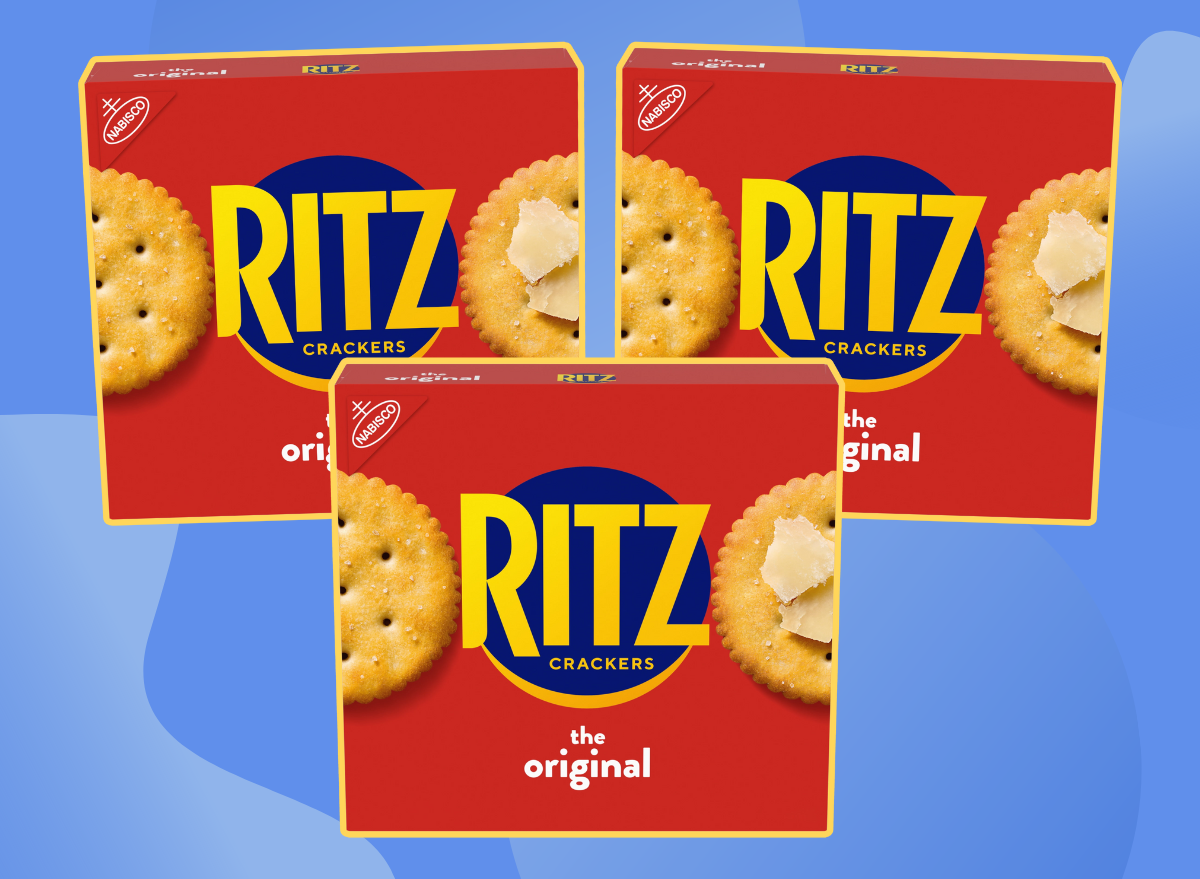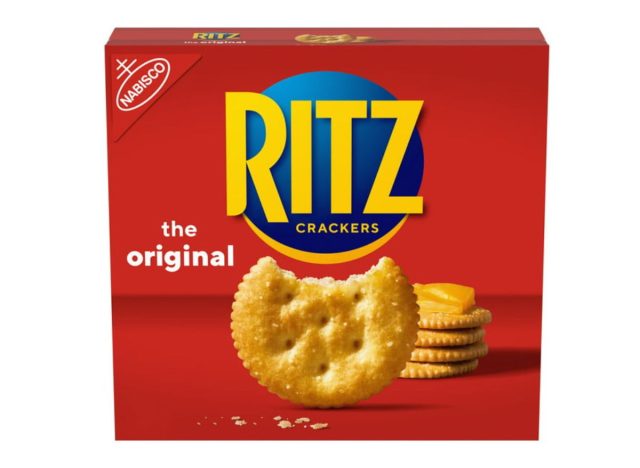Are Ritz Crackers Healthy? What a Dietitian Wants You To Know

Snacking accounts for about 20% of the average American's daily calorie intake, yet our choices aren't always the healthiest. Popular culture is full of conflicting messages about snacking, and while there's no shortage of options, we often gravitate towards chips, cookies, and other highly palatable, energy-dense treats. But snacking doesn't have to be unhealthy.
If you're looking for a better option, the cracker aisle might catch your eye. With their salty, savory, and crunchy appeal, crackers offer a satisfying snack with generally less fat than chips. Among these, Ritz Crackers are a timeless favorite—a little salty, a little buttery, and slightly sweet. Though they may not win the healthy choice award, they're an affordable snack that can fit into a balanced diet.
But are Ritz Crackers really good for you? As a dietitian, I examined their nutrition and ingredients to see how they ranked as a healthy snack choice.
What Are Ritz Crackers? History & Ingredients
Ritz Crackers have been a staple snack for nearly 100 years. Originally developed in the 1930s as an "affordable luxury" during the Great Depression, the name "Ritz" was chosen to evoke a sense of luxury and was short for ritzy.
Ritz Crackers are known for their soft, buttery taste and round, golden shape. They're a versatile food that pairs well with cheese, peanut butter, or dips, making them a popular choice for snacking. They even make a good crust for miniature pizzas, topping for casseroles, and breading for chicken.
While Ritz Crackers are a processed food, the ingredients list might be shorter than expected. However, it includes some components you may want to limit in your diet.
The first ingredient is unbleached enriched flour, which means it has added vitamins and minerals. Following that are oils like soybean, canola, and palm oil, which give the crackers their signature buttery flavor. Palm oil, a saturated fat commonly used in ultra-processed foods, helps enhance taste and texture. Although it's used instead of trans fats, which were banned by the FDA in 2018 due to their negative impact on cholesterol, there's still debate over whether palm oil is a healthier alternative. Research, including a 2021 review published in Nutrients, suggests that palm oil raises both LDL (bad cholesterol) and HDL (good cholesterol).
Despite being more salty than sweet, Ritz Crackers contain two sweeteners: sugar and high fructose corn syrup. High fructose corn syrup is a processed sugar linked to increased inflammation and potential health concerns like obesity and metabolic syndrome.
The ingredient list also includes salt, baking soda, soy lecithin, and natural flavors. Soy lecithin is an emulsifier that helps blend ingredients, while natural flavors may include any food-based herb, spice, or essential oil.
Nutritional Content of Ritz Crackers

Ritz Crackers is a line of crackers that includes sandwich crackers (Ritz cheese sandwich crackers), flavored crackers (honey wheat, garlic, and roasted vegetables), whole wheat crackers, and low-salt crackers called Hint of Salt. The nutritional content is based on the Original Ritz Crackers.
Calories: 80
Fat: 4 g (Saturated Fat: 1.5 g)
Sodium: 130 mg
Carbs: 10 g (Fiber: 0 g, Sugar: 1 g)
Protein: 1 g
Health Benefits of Ritz Crackers

Ritz Crackers are a classic snack food that offers some health benefits.
Source of Energy
About 50% of calories in Ritz Crackers comes from carbs. Despite the popularity of low-carb diets, carbs aren't all bad and provide the body with its preferred source of energy: glucose. A balanced diet should get 45-65% of calories from carbohydrates, or about 900 to 1,300 calories on a 2,000-calorie diet.
Easy To Digest
For overall health, whole grains are better. But if you're recovering from the stomach flu or have a flare-up of your ulcerative colitis, your gut may prefer low-fiber foods that are easier to digest, like Original Ritz Crackers, which have no fiber.
Vehicle for Healthy Toppings
Ritz Crackers are sweet and savory and pair well with many toppings, making them a great vehicle for adding flavor, variety, and nutrition to your diet. Of course, cheese makes a good choice, but you can also top your Ritz Crackers with hummus, nut butter, mashed avocado, tomatoes, salsa, or turkey.
You can also make little pizzas, topping the flaky crackers with sauce, cheese, and basil and baking in the oven until the cheese melts.
Health Drawbacks of Ritz Crackers

It may not come as a surprise that Original Ritz Crackers has more health drawbacks than benefits.
High in Fat
Carbs provide the bulk of the calories in Ritz Crackers, but fat provides the rest, making up 45% of the calories in every serving. Though the cracker uses vegetable oils, palm oil adds saturated fat, meeting 8% of the daily value per serving.
No matter the source, limiting overall saturated fat intake to 10% of calories (22 grams of saturated fat a day on a 2,000-calorie diet) is recommended for heart health.
Made With Refined Flours
One of the major drawbacks of Original Ritz Crackers is that their main ingredient is refined flour, which has no fiber. The cracker is made with enriched flour, which has added B vitamins and iron.
Ritz Crackers Whole Wheat version is made with whole grain wheat flour, providing 1 gram of fiber per serving and meeting 3% of the daily value. It's not great, but a little better if you want to add more fiber to your diet. Currently, 95% of Americans don't get enough fiber, so every extra gram helps. Getting more fiber improves bowel function and may lower the risk of heart disease.
Not a Good Source of Nutrients
Nutrition information on the Nutrition Facts label for Ritz Crackers is limited. But it's not a significant source of any of the nutrients listed, meeting only 2% of the daily value for iron. USDA FoodData Central provides a little more nutrition information, showing that the crackers, despite using enriched flour, aren't a significant source of any nutrient, meeting 5% or less of the daily value for thiamin, riboflavin, folate, and niacin.
Source of Sodium
Lightly salted, a serving of Ritz Crackers meets 6% of the daily value for sodium. The crackers are not significantly high in sodium, but as sodium is a nutrient most people get too much of, it's good to be careful. High intakes of sodium may increase the risk of high blood pressure, and you should limit your daily intake to 2,300 milligrams a day.
Ritz Hint of Salt Crackers is a lower sodium option, meeting 1% of the daily value.
Are Ritz Crackers Healthy?

Ritz Crackers aren't the healthiest crackers on the shelf, but they have their place in a balanced eating plan. The refined flour crackers are easy to digest and provide a little energy and sodium for those recovering from a stomach virus. They also make a good foundation for nutrient-rich foods like nut butter, avocados, tomatoes, and hard-boiled eggs.
Triscuits Original Crackers, Flackers Flax Seed Crackers, and Simple Mills Rosemary & Sea Salt Almond Flour Crackers make better choices if you're looking for a healthier cracker. These crackers are made with whole grains or whole foods and pack in more fiber than Original Ritz Crackers.
- Source: https://www.sap.org.ar/docs/publicaciones/archivosarg/2021/v119n5a05e.pdf
- Source: Unhapipatpong, C., Shantavasinkul, P. C., Kasemsup, V., Siriyotha, S., Warodomwichit, D., Maneesuwannarat, S., Vathesatogkit, P., Sritara, P., & Thakkinstian, A. (2021). Tropical Oil Consumption and Cardiovascular Disease: An Umbrella Review of Systematic Reviews and Meta Analyses. Nutrients, 13(5), 1549. https://doi.org/10.3390/nu13051549
- Source: Li, X., Luan, Y., Li, Y., Ye, S., Wang, G., Cai, X., Liang, Y., Kord Varkaneh, H., & Luan, Y. (2022). The effect of high-fructose corn syrup vs. sucrose on anthropometric and metabolic parameters: A systematic review and meta-analysis. Frontiers in nutrition, 9, 1013310. https://doi.org/10.3389/fnut.2022.1013310
- Source: List, G. (2015). Soybean lecithin: Food, industrial uses, and other applications. In Elsevier eBooks (pp. 1–33). https://doi.org/10.1016/b978-1-63067-044-3.50005-4
- Source: Frank, S. M., Jaacks, L. M., Adair, L. S., Avery, C. L., Meyer, K., Rose, D., & Taillie, L. S. (2024). Adherence to the Planetary Health Diet Index and correlation with nutrients of public health concern: an analysis of NHANES 2003-2018. The American journal of clinical nutrition, 119(2), 384–392. https://doi.org/10.1016/j.ajcnut.2023.10.018









